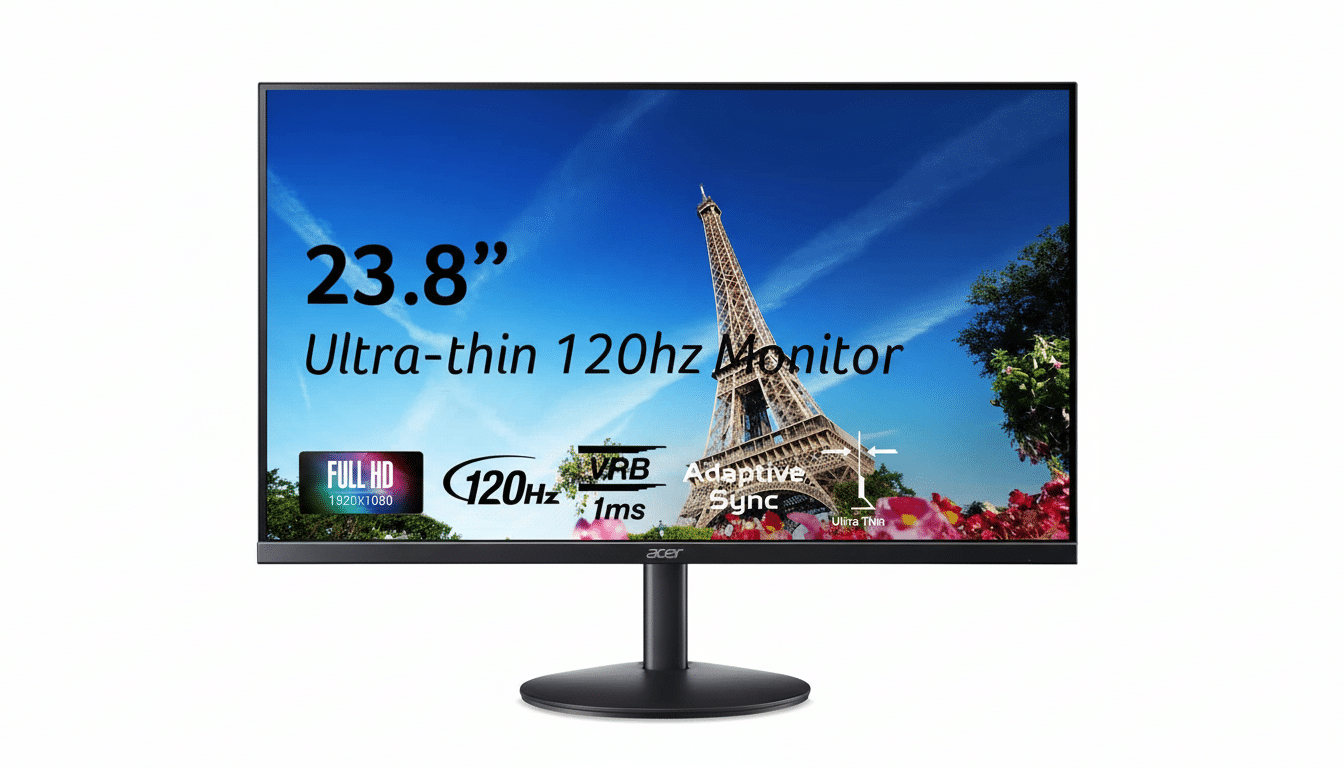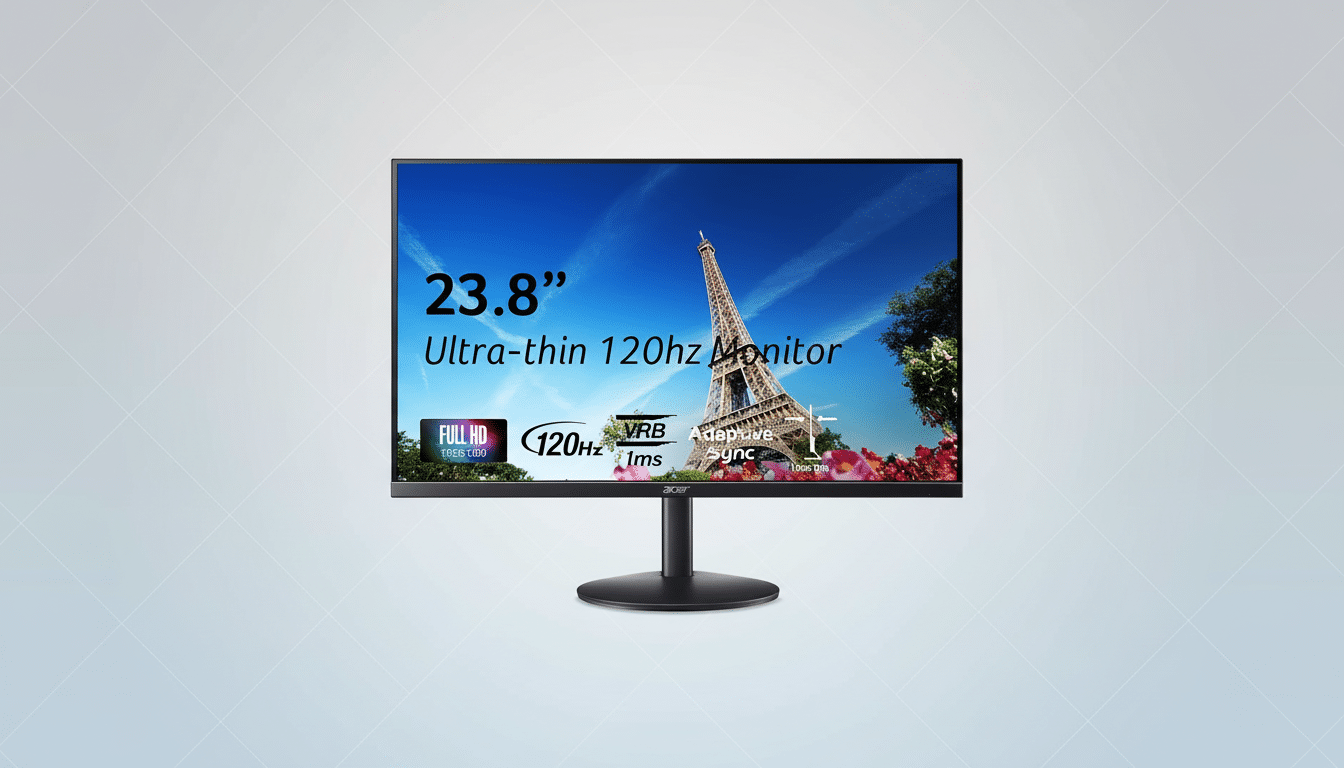A sharp price drop puts the Acer SB243Y G0bi on the short list for a budget upgrade. It’s now $89.99, down from $129.99—a 31 percent cut—for a 23.8-inch IPS Full HD monitor that punches above its weight with a 120Hz refresh rate, Adaptive-Sync support compatible with FreeSync, and a clean, zero-frame aesthetic that fits tight desks and dual-screen setups. For students, remote workers, and casual gamers, it delivers the kind of smoothness and color consistency you rarely see under $100. If you need a second screen for spreadsheets by day and indie matches by night, this is a well-judged sweet spot.
Why this budget 120Hz IPS monitor stands out under $100
Most sub-$100 monitors stop at 60Hz or 75Hz. The SB243Y G0bi goes to 120Hz, making everyday scrolling, timeline scrubbing, and video playback feel noticeably more fluid. Paired with Adaptive-Sync, that also helps cut tearing in fast-moving games, provided your GPU output matches the variable refresh window. AMD’s FreeSync framework was built for precisely this use case, reducing perceived stuttering without the punishing complexity of traditional V-Sync scenarios. The IPS panel covers up to 99 percent of sRGB, which means you’ll see uniform colors across typical web and office workflows. Wide viewing angles also matter if you share screen real estate in meetings or run a two-monitor array—which is where IPS panels generally outshine budget VAs.
- Why this budget 120Hz IPS monitor stands out under $100
- Key specs that matter for this $90 Acer 120Hz monitor
- How a 120Hz IPS display fits into everyday workflows
- How this Acer SB243Y G0bi compares with budget rivals
- What you sacrifice at this price compared with pricier picks
- Bottom line: who this $89.99 Acer 120Hz monitor is for

Key specs that matter for this $90 Acer 120Hz monitor
- Size and resolution: 23.8 inches, 1920×1080, the mainstream for the market. Market research firms such as IDC and Omdia consistently list boxes of 23.8– to 24.5-inch, 1080p monitors as the volume leader in business and home setups, which helps keep prices low while accessories and mounts are widely compatible.
- Refresh and response: 120Hz with Adaptive-Sync support ensure super-smooth gameplay and are stutter- and tear-free. Acer’s 1ms VRB mode — a backlight-strobing feature that can further sharpen motion — is available too, but like other such strobing modes, it incurs a reduction in brightness and is usually incompatible with variable refresh.
- Color and comfort: An IPS panel gives an sRGB of over 99% for the web and office that provides vibrant visuals at all angles. The non-glare screen finish, and eye-comfort features that Acer includes like flicker reduction and blue-light controls, are all pluses during long sessions under mixed lighting.
- Design & I/O: The zero-frame design provides the maximum viewing area, creating a more seamless look for multi-monitor setups. Connectivity is old- and new-school: HDMI 1.4; a VGA port — and there’s even an HDMI cable in the box to get you going. The stand is tilt-only, but the 100×100 VESA allows one to relocate it to an arm for better ergonomics.
But again, expect brightness and contrast in this class to be around 250 nits and 1,000:1, which is par for the course for budget IPS panels. You’re not going to get HDR here, but you will at least get a clean, color-accurate image that can be driven quite easily by integrated graphics.
How a 120Hz IPS display fits into everyday workflows
120Hz makes a difference in the office, too, cutting down on eye strain as you flip through long spreadsheets or toggle between browser tabs. Video calls and screen shares appear smooth, and wide viewing angles help maintain color if you’re looking at documents on one screen and editing on the other.
For gaming, 1080p at 120Hz is kind to tame hardware: from older GTX cards and integrated Radeon 700M Chromebooks to Intel’s Arc-integrated Core Ultra chips. Competitive experiences like Valorant, Rocket League, and Fortnite can touch triple-digit frame rates on mainstream systems, so Adaptive-Sync gets to do its thing.
For graphic designer-type people working in sRGB, it is good enough for web-based design work. If you’re consistently delivering in DCI-P3 or need to do true HDR mastering, you’ll want to upgrade to a higher-tier display; for regular photo edits and working on pen-size thumbnails, it’s more than adequate.
How this Acer SB243Y G0bi compares with budget rivals
Common budget competitors such as Dell’s SE series or Asus’s 24-inch VA/VP models usually max out at 75Hz, sacrificing smoothness for a modest price drop. AOC’s 24G2 and other popular gaming-focused 24-inch IPS monitors bring that up to a 144Hz refresh rate and throw in height-adjustable stands, but generally they are much pricier (and still don’t drop below around $120–$150 during sales).

Which leaves the SB243Y G0bi in a bit of an oddball lane: an IPS with 120Hz and Adaptive-Sync for less than $100. Add VESA mounting and an included HDMI cable, and the setup friction gets about as low as it goes.
What you sacrifice at this price compared with pricier picks
There are no extra stand movements — it only tilts, sans height adjustment, swivel or pivot capability. There is no USB hub, and the brightness is good rather than punchy so a sunny room may need judicious positioning. There’s a 1080p panel, so the screen size is still feasible for productivity and esports but doesn’t quite get to the desktop real estate you can have with 1440p screens. And 120Hz is indeed a big upgrade, though it’s nothing like 144Hz or 240Hz; fast-twitch purists may still find pricier options more appealing.
Finally, motion-blur reduction through VRB is a tool, not a magic switch; it should be used selectively as it can dim the image and usually cannot run alongside Adaptive-Sync.
Bottom line: who this $89.99 Acer 120Hz monitor is for
The Acer SB243Y G0bi is a lot of value at $89.99: professional-grade LCD technology for IPS color, buttery 120Hz, and Adaptive-Sync ready to go in a compact screen with VESA mount compatibility.
If you need a budget second monitor for a home office, space-saving dorm setup, or entry-level gaming display that feels responsive without requiring you to have a killer GPU on the other end of the card, this deal argues there’s no time like today to do just that.

